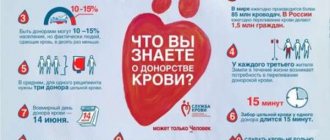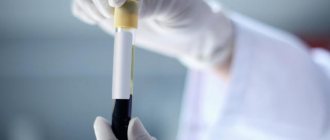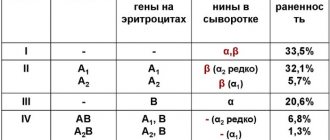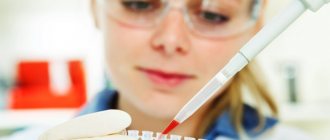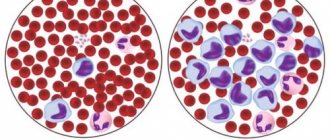1
Author of the article: Marina Dmitrievna
2017.10.11
21 258
Blood analysis
Seven to eight percent of a person’s body weight is occupied by blood - the most important participant in life, performing a huge number of functions. The blood of all people is divided into groups; today there are four of them. The Rh factor is taken into account separately: it is either positive or negative. Some people know blood data from birth, while others receive this information at some point in life. But what is the difference between the different types, and which blood type is the best? Each variety has its own disadvantages and advantages that are worth knowing about.
Red blood cells carry specific antigens
What are the characteristics of a person's blood group?
Even in ancient times, the followers of Hippocrates expressed the opinion that people have different blood substances, although their ideas are far behind modern ones. For the first time, geneticists were able to determine such an important feature of our circulatory system. After examining a significant number of people, it was found that there are 3 types of antigenic properties of blood cells. Moreover, these individual characteristics have been preserved since ancient times. Of course, it is also customary to isolate the Rh factor for human blood. Let's consider the characteristics of each group taking into account the Rh factor.
Due to Rh positive, the first positive GC has the D antigen. It is the most common GC, found in approximately 40% of the world's population. The first negative blood group does not have agglutinogens and surface antigens. It is classified as a shortage category. The group is relatively rare, occurring in only 15%.
The second positive has an agglutinogen and a surface specific antigen. Its prevalence rate is around 30%, which is very good for its owners. The second negative HA is distinguished by agglutinogen A and does not have a surface antigen. This is not the rarest group, but it is less common than the second positive group (approximately 27%).
A person with the third positive group has a remarkable feature - the presence of agglutinogen B and surface antigen D. It is one of the rarest and therefore cannot be considered the best. Even rarer is the third negative. It has agglutinogen B and is characterized by the complete absence of antigens.
The fourth positive HA is considered the most surprising and at the same time perhaps the rarest. It is distinguished by the presence of red blood cells A and B, so it is often called mixed. Rh positive results from the presence of surface antigens and occurs in only 7%.
The rarest blood group (about 6%) is fourth negative. It is not difficult to guess that it has the same features as the previous one, but there are no surface antigens.
For Sport
Blood type is associated with physical indicators: endurance, flexibility, reaction speed and strength. Let's look at these features and the sports that are most likely suitable for various GCs.
00
People with this type are distinguished by endurance and high coordination of movements, thanks to this they achieve success in many sports.
What to do: rhythmic and artistic gymnastics, long-distance running, race walking, figure skating, synchronized swimming.
0A
People with the second HA are not suitable for martial arts, but at the same time they achieve success in tactically complex sports. They often engage in weightlifting, athletics, and team sports. What to do: athletics, curling, tennis, football, hockey, basketball, triathlon, biathlon.
0V
It was believed that this blood type was best suited for sports that required high levels of speed and coordination. Among martial arts professionals there are many people with the third GK.
What to do: boxing, karate, jiu-jitsu, all-around, diving, swimming.
AB
People with IV HC have different muscle strength. Strength sports that do not require speed of movement are suitable. What to do: windsurfing, powerlifting, weightlifting.
Important information: How to find out your blood type and determine the Rh factor without tests at home
What blood type can be considered the best?
It can be concluded that the more common HA is, the better for a person. But you cannot be guided only by the Rh factor and number. However, most often in medicine donors with the first positive are required. Its versatility allows it to provide donors for other groups. It is versatility that is an important criterion, which makes the first positive one the best. At the same time, it must be remembered that when transfusing blood, maximum sample identity should be taken into account.
Classification
Nowadays, human blood is classified according to the ABO system and the Rh factor. According to this classification, four groups are distinguished: first (0), second (A), third (B), fourth (AB).
- Each of them can be Rh positive or Rh negative, which means there are 8 types of blood. The question may arise as to which one is the best.
- Some blood can be considered better than others only if its owner can always quickly find a donor in case of significant blood loss.
- Thus, we can conclude that the best group is the most common.
What blood is most common?
According to statistics, about half of all inhabitants of the planet have blood of the first group, about 40% are carriers of the second, approximately 8% of the population have the third group, and only 2% of people have the fourth.
The vast majority (85%) are owners of Rh-positive blood, and only 15% do not have a specific protein on the surface of red cells - the Rh factor.
From this we can conclude that the best group is I positive, and this means that such blood can always be found, unlike the fourth negative.
The best one is universal?
Group 0 (first) blood is called universal because it is believed that it can be transfused to everyone. The fact is that it does not have antigens A and B on red blood cells, which means that the recipient’s body will not begin to produce antibodies against them. Thus, the first group can be considered the best, since its carrier can save any person in case of blood loss.
On the other hand, AB can be transfused only to owners of the same one, and to no one else. At the same time, anyone can become a donor for a person with IV, since AB blood plasma does not contain antibodies to antigens A and B.
You should know that such compatibility exists only theoretically. In modern conditions, it is forbidden to transfuse another group and with a different rhesus. The donor and recipient must have the same blood in both respects. An exception to the rules can be made only in case of urgent need.
Blood type and predisposition to disease
There is an assumption that, depending on the blood, people are prone to certain diseases, but this has no scientific basis.
I (0)
These people are considered to be mentally stable. As for diseases, they are predisposed to arterial hypertension and diseases of the digestive system.
Due to the increased acidity of gastric juice, they may develop gastritis, peptic ulcers, and colitis.
They suffer from influenza and ARVI more often than others, they have a tendency to form stones in the urinary system, and have poor blood clotting. With negative Rh, skin pathologies may be observed.
Why is maximum blood type compatibility important for a person?
Blood transfusion is one of the most important inventions in medicine. In ancient times, they did not know about the possibility of preserving life in this way. Many people died from blood loss both during wars and in everyday life. In ancient times it was impossible to identify a group. Moreover, an important discovery was made only after World War II.
It was World War II that prompted scientists to wonder how compatible human red blood cells were. Versions about the difference in circulatory systems appeared, dependencies were derived, and numerous experiments were carried out. Later, a version appeared that the first negative HA was absolutely compatible, and its owners were declared universal donors. It has now been established that a person with the first negative can be a universal donor only as a last resort, and transfusion is allowed in a volume of no more than 500 ml.
Surprisingly, doctors for a long time did not encounter a problem when transfusing “universal” blood, so there were no alarms. Of course, for that time it was considered the best. Nowadays single-group transfusion is practiced. It is known that different antigen systems need to be taken into account; the donor’s circulatory system, which differs in antigens from the recipient’s system, can give rise to a conflict that will have detrimental consequences. Cryopreservation is used in medicine, and almost everyone can donate their own blood so that it is prepared for an emergency.
Most common group
Today, the second and first types are considered the most common and accessible. It's hard to say which one is best, because in case of transfusion, it's quite easy to get both. It is known that almost 80% of the entire population of the planet goes with the first and second groups. The remaining 20% comes from the third and fourth.
The only positive qualities of this prevalence are that the first and second blood groups are quite easily suitable for transfusion . That is, the second group may be suitable for the patient for the first, with the exception of the selection of Rh. For example, back in ancient times, they were not at all interested in blood type; they selected only positive or negative Rh factor. After all, these indicators cannot be categorically mixed.
Blood transfusions are done not only to save a person’s life, but also for cosmetic purposes, for example, when fighting acne (pimples): https://krasnayakrov.ru/donorstvo/perelivanie-krovi-ot-pryshei.html
What role does plasma play?
Blood plasma is the liquid part, it is usually called the second part of the blood. The word plasma has ancient roots, meaning something formed. The percentage of plasma content is significant and can be up to 61%. The color of plasma has a yellowish tint; it plays a vital role as an intercellular substance.
To obtain plasma, special centrifuges are used. Proteins and various mineral compounds dissolve in plasma. Plasma is also an important source of vitamins, enzymes, hormones, and inorganic substances. This is what contains water. For 1 liter of substance there is approximately 900 g of water. This substance is actively used in medicine, for example, in the presence of a high concentration of platelets, it can be used to stimulate healing and regeneration. A plasma-based method has been created that is used by dentists and cosmetologists.
Previously, it was believed that plasma did not have antigens, so volumes were not monitored during transfusion. But it is now known that the plasma of the first group contains agglutinins A and B. This fact necessitates the introduction of a limited volume so that the donor agglutinins can dissolve in the recipient’s plasma. Plasma with the fourth group does not contain agglutinins, so it is considered the best, because it can be transfused to the recipient regardless of his group.
Transfusion Basics
You need to understand that in the modern medical world it is forbidden to transfuse, unless absolutely necessary, blood that differs from the recipient’s group. It is completely prohibited and has an excellent Rh factor. Ideally, the transfusion should be the same type as the recipient.
The Rh factor in donation is an important indicator that is passed on to children by inheritance. It is located in blood components, various organs, and amniotic fluid. When a person who has a negative Rh factor is transfused with a positive type, the body begins to produce specific antibodies. We can say that the body is protecting itself from something foreign.
Often becomes a problem for bearing a child.
Therefore, pregnant women with negative Rh, if their husband has a positive one, are examined more thoroughly.
You can be sure that if not the first, then the second transfusion can be fatal for a person with a different Rhesus blood from the blood being transfused. It is also worth emphasizing that in people with positive Rh, it can be of several types or one. That is, you can see a combination of different types, which is also important to consider when transfusion. Therefore, it is important to determine what kind of blood the recipient has and what kind of blood the person who donated the material has.
What is the history of blood groups?
Since ancient times, it was believed that blood is a mystical liquid, and still some peoples, especially African tribes, endow it with mystical properties, following the behests of ancient ancestors. They learned about blood circulation only in the 17th century thanks to the English physician William Harvey.
The legend about Pope Innocent says that he once began to receive blood transfusions, and this happened at the end of the 15th century. The experiment was unsuccessful, and other attempts also failed. Some blood transfusion techniques were barbaric. For example, one of the doctors in the 17th century tried to transfuse the blood of a dog to a person. Oddly enough, in 1667 the experiment of transfusion from animal to human was crowned with success. Lamb blood was used for the experiment. The patient was a young man suffering from an unknown disease. Thanks to the procedure, he was able to recover. Nevertheless, even the best attempts caused a negative reaction from both ordinary people and the medical community. In some countries, blood has been banned for medical procedures.
The first transfusion from one person to another happened only in 1795. Fearing condemnation, doctor Philip Sing was afraid to tell the world about it. As a result, the fate of the transfusion was decided by an incident when in 1818 one of the patients urgently needed to undergo a vital procedure. The doctor used her husband's blood to save the girl. This doctor was James Blundell, a British obstetrician who also created the first instruments to make the complex procedure easier.
Professor Stepan Khotovitsky made his contribution to the study of the issue, who at that time achieved the best successes, preparing the ground for future specialists.
Who is the donor to whom? What you need to know about blood type?
Blood supplies the body with vital elements - amino acids, carbon, fats, oxygen. There are four blood types, and each of us is the owner of one of them. Which vessels interact with each other? Do they have distinctive features? AiF-Krasnoyarsk looked for answers with the help of an expert - gastroenterologist Tatyana Mayorova.
What period became a turning point for the study of blood type?
At a certain point, it became clear to the scientific community around the world that it was necessary to get rid of the prejudices that had reigned since ancient times regarding blood. Even the press wrote about the importance of considering this burning issue. It is impossible to imagine what benefit people would have had if its consideration had been taken up as early as possible.
Only at the beginning of the 20th century, thanks to Karl Landsteiner, 3 main groups were discovered. The fourth was opened a few years later. By the 40th year of the 20th century, the world learned that humans have antigens (Rhesus). Therefore, the scientifically based history of such a trivial liquid for the average person began quite recently. Now in the world of medicine it is known that blood is not only a liquid, but also a tissue. This is explained by the need to take into account immunological data, so blood is not simply transfused, but transplanted, similar to other human tissues.
Features of transfusion
Today, in the world, human blood is classified according to the ABO system, as well as the Rh factor. According to this classification, a person can have one of four groups:
- the first is designated by the number 0;
- the second letter A;
- the third letter B;
- the fourth is a combination of their AB.
Moreover, each can have a positive or negative Rh factor. Accordingly, human blood can be divided into four groups or eight types. In this regard, the question often arises, which is the best.
Most often, the question of which blood is the best arises when it comes to donation. That is, it is assumed that it is best to have the type that occurs most often. That is, the most common blood should be the best, but is this really so?
Prevalence and versatility
The most common all over the world, according to research, is the first. About half of the world's inhabitants have this type. In second place is the second one.
What is the relationship between blood type and human health?
In popular science articles on medical topics, you can often see a question about the best blood type from the point of view of human health.
The first group is considered the oldest. It is so ancient that, according to scientists, its history began 40 thousand years ago. Previously, from the standpoint of assessing health, it was considered the best. But now it is common to assess the likelihood of developing diseases.
In experiments conducted in 2012 by Harvard University (Institute of Public Health), it was found that owners of the following BGs are most at risk of developing cardiovascular diseases:
- A2;
- B3;
- AB4.
Accordingly, the letters represent antigens. The best situation is for those in the fourth group (AB), who are 23% less likely to suffer from cardiovascular diseases.
There are other studies that were aimed at studying predisposition to various types of diseases, taking into account GC. However, the practical significance of these studies remains to be determined in the future. Currently, there is no unambiguous evidence that would make it possible to confidently predict and prevent the development of the disease in a person, taking into account his blood type.
Does universal mean the best?
There are universal donors - these are people with the first group. This is because there are no antigen proteins on their red blood cells, so the recipient’s body does not perceive it as foreign and does not produce antibodies that destroy the infused cells. Due to its versatility, the first group is considered the best.
And blood types with A and B proteins can only be infused into people with the same set. There is also a universal recipient - a person with the fourth group. His body will accept any set of antigens.
Incompatibility of biomaterial or Rh conflict
However, the above rules do not apply in practical medicine. Today it is forbidden to mix different groups and Rh factors. Therefore, both the donor and the recipient must have the same set of proteins. Exceptions are made only in emergency cases.
And yet, which group is the most popular?
Based on the information provided, two conclusions arise:
- The most in demand blood group is I (0) Rh+, since the vast majority of people have this group.
- There are much fewer IV (AB) Rh positive and negative ones, which is why it is more difficult to find. This is because there are very few people with such blood flowing in their veins. And if the patient has to undergo a transfusion, it will be difficult to find a donor.
What role can HA play in oncology?
Obviously, there is no direct relationship and it is impossible to assess a person’s health only by his BG. There are many specialists who conduct serious research trying to find a relationship between markers and the development of cancer. Thus, specialist Peter D'Adamo has been analyzing the relationship between markers and the incidence of cancer for 20 years. But no serious results have yet been achieved.
It is impossible to say for sure which HA is the best for health. However, in some countries they pay a lot of attention to it and even consider it a cult. An example is the Japanese, who use blood type data every day. It is used to choose a spouse, evaluate career opportunities, and much more. But even in ancient times, they realized that what is important is not what kind of physiology a person has, but the combination of all factors at once. In ancient times, people paid no less attention to their health than they do now. Medical treatises on nutrition have been preserved, and the Chinese people have distinguished themselves with particular success. Modern man can ensure his health and longevity, using much more opportunities than people had in ancient times. The main factor in this matter remains his own desire.
What blood type is most common among Russians?
Blood is an identifying indicator of personality that is passed from father to child and does not change throughout life. Blood groups are considered older than human race and nationality. According to scientists, the main difference between all people is not skin color or ethnic origin, but blood.
The composition of the blood has changed and formed over thousands of years, which is associated with the formation of human immunity and its digestive system. In those days, the human esophagus was best at processing protein foods (mostly). This feature has influenced the fact that now people with the first blood group have increased stomach acidity, and they suffer from peptic ulcers more often than others.
Over time, when the population began to increase, people began to include plant foods in their diet, since there was no meat in the required quantity. The consumption of plant foods affected the composition of the blood, and therefore three other blood groups arose. New groups endowed people with useful qualities.
So people with gene A are considered the most adapted to life in modern conditions. This gene was previously a guarantee of human survival during epidemics such as cholera and plague.
